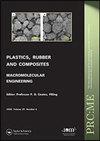研究了复合多层氧化石墨烯/滑石作为疏水剂在环氧涂料中的应用效果
IF 1.2
4区 材料科学
Q3 MATERIALS SCIENCE, COMPOSITES
引用次数: 4
摘要
摘要采用滑石粉对多层氧化石墨烯(MLGO)进行改性,通过三种不同的方法制备环氧树脂疏水耐蚀剂。在360 h和500 h后分别进行了湿度和盐雾试验,结果表明回流法制备的样品性能优于加热搅拌法和微波法制备的样品。FT-IR结果表明,在滑石粉的存在下,MLGO上的部分含氧官能团减少。同时,对MLGO/Talc质量分数为1%wt时,MLGO/Talc质量分数为1:5的涂料进行了实验测试,结果表明MLGO/Talc质量分数为1:5的涂料效果最好。浸泡2个月后,MLGO - Talc、MLGO和Talc环氧涂料的阻抗模量分别为1.45 E+07、1.38 E+06和6.72E+05 Ω cm2。因此,通过回流法获得了一种疏水的MLGO/滑石结构,并通过接触角试验进行了验证。本文章由计算机程序翻译,如有差异,请以英文原文为准。
The effect of the hybrid multi-layered Graphene oxide/Talc as a hydrophobic agent in epoxy coating
ABSTRACT Multi-layered Graphene oxide (MLGO) were modified with Talc to prepare a hydrophobic corrosion resistance agent for epoxy through three different methods. The humidity and salt spray tests after 360 and 500 h, respectively, showed the higher performance of the sample prepared by the reflux method compared to the heater-stirrer and microwave method. The results of the FT-IR showed that in the presence of Talc, some of the oxygenated functional groups on MLGO were decreased. Also, the comparison of the experimental tests of the coatings containing 1%wt of MLGO/Talc with the different ratios of MLGO and Talc showed the best results for MLGO/Talc (1:5). The impedance modulus of MLGO–Talc, MLGO and Talc epoxy coatings at the end of two months of immersion were 1.45 E+07, 1.38 E+06 and 6.72E+05 Ω cm2, respectively. So by the reflux method, a hydrophobic MLGO/Talc structure was obtained that was confirmed by the contact angle test.
求助全文
通过发布文献求助,成功后即可免费获取论文全文。
去求助
来源期刊

Plastics, Rubber and Composites
工程技术-材料科学:复合
CiteScore
4.10
自引率
0.00%
发文量
24
审稿时长
4 months
期刊介绍:
Plastics, Rubber and Composites: Macromolecular Engineering provides an international forum for the publication of original, peer-reviewed research on the macromolecular engineering of polymeric and related materials and polymer matrix composites. Modern polymer processing is increasingly focused on macromolecular engineering: the manipulation of structure at the molecular scale to control properties and fitness for purpose of the final component. Intimately linked to this are the objectives of predicting properties in the context of an optimised design and of establishing robust processing routes and process control systems allowing the desired properties to be achieved reliably.
 求助内容:
求助内容: 应助结果提醒方式:
应助结果提醒方式:


